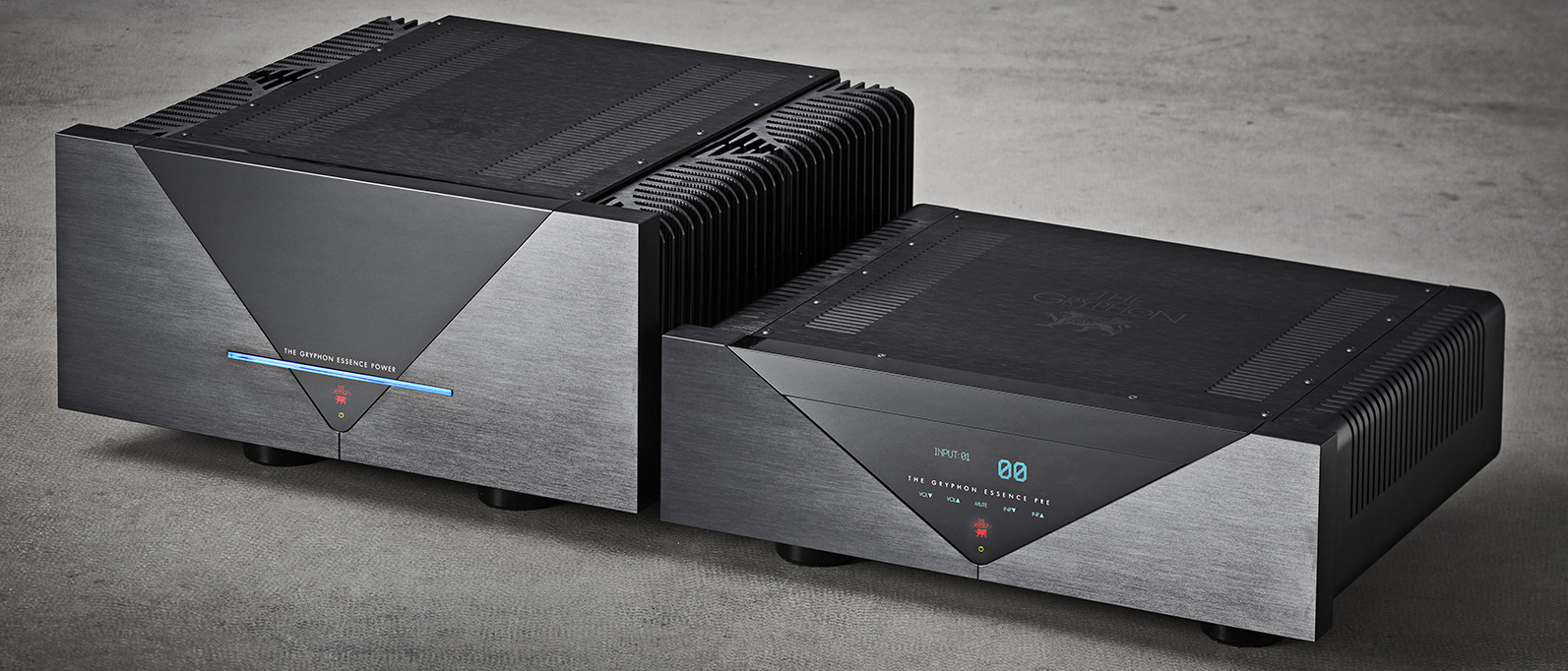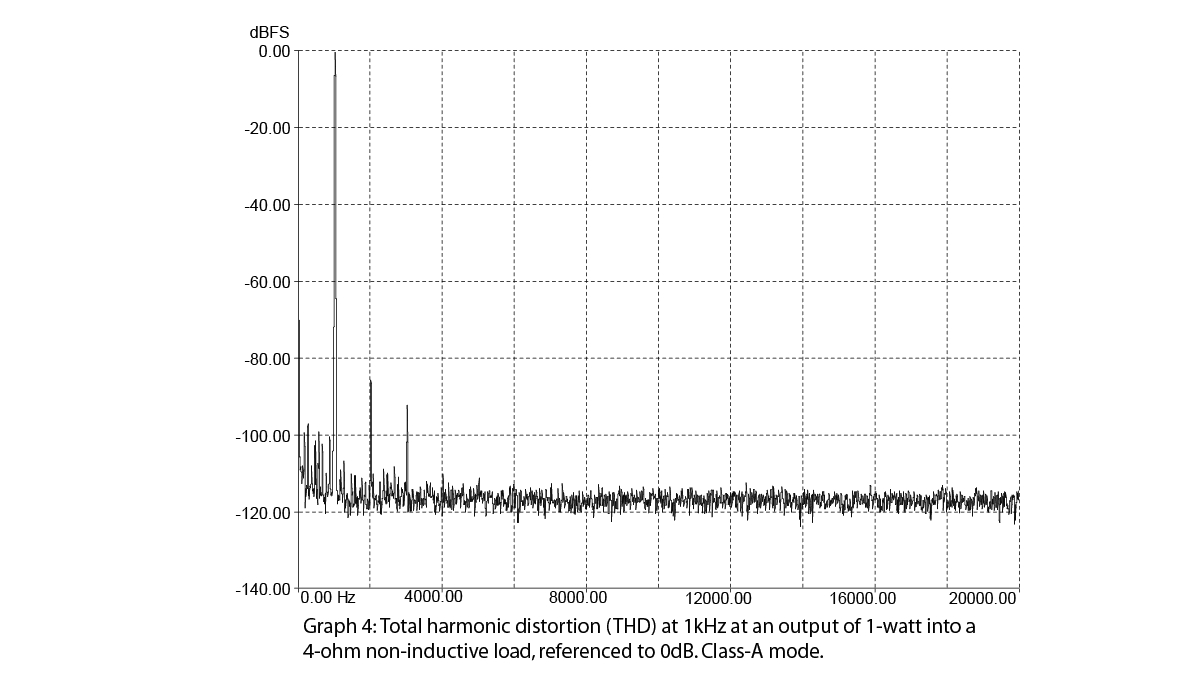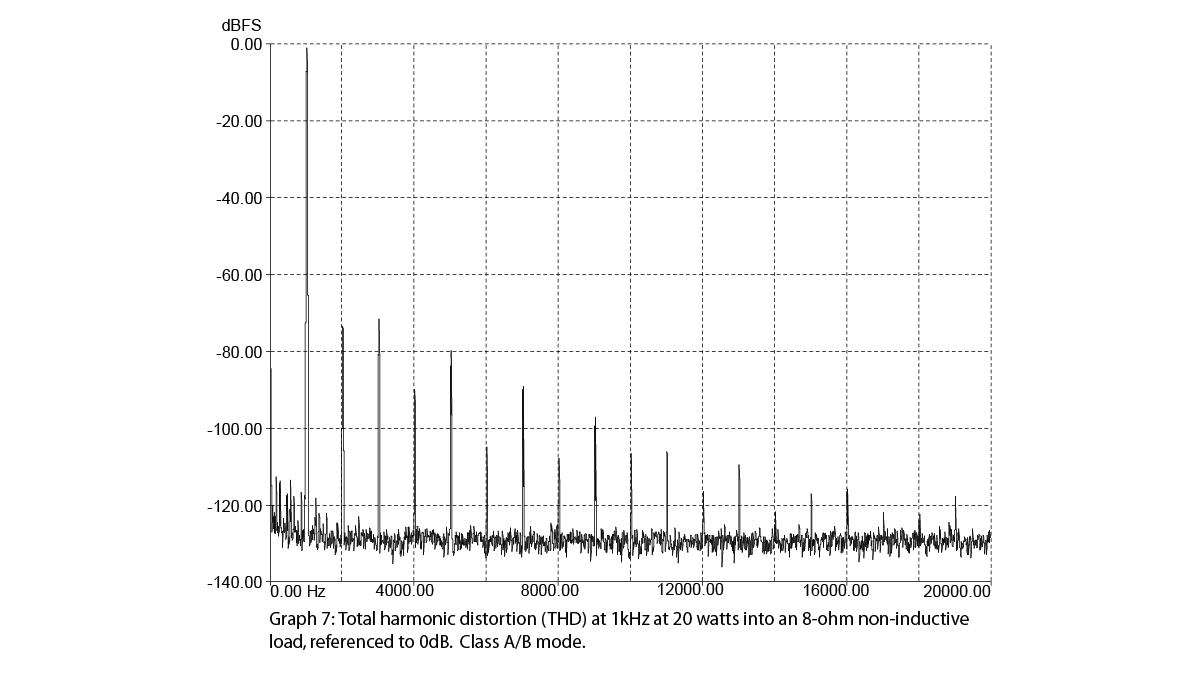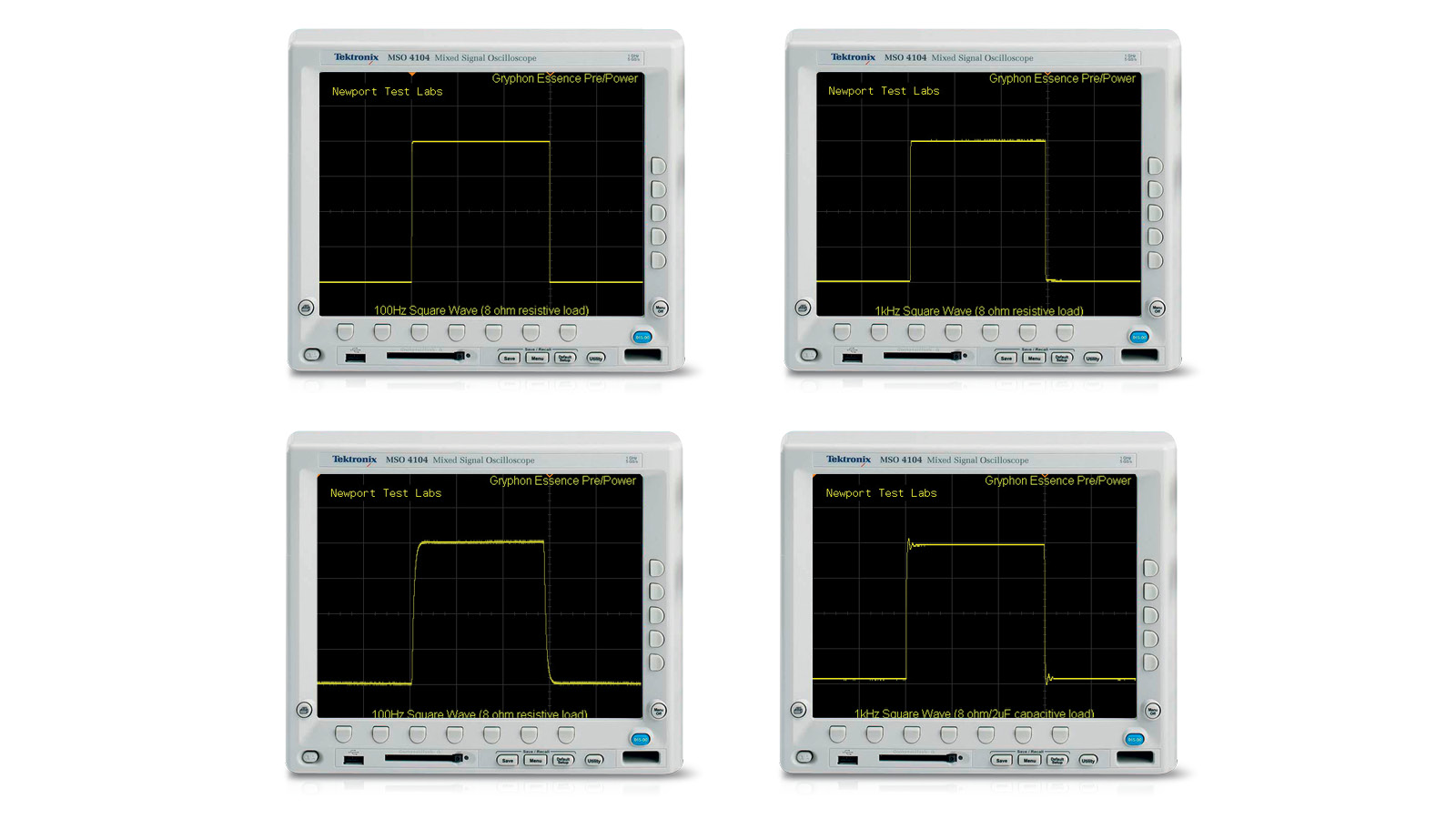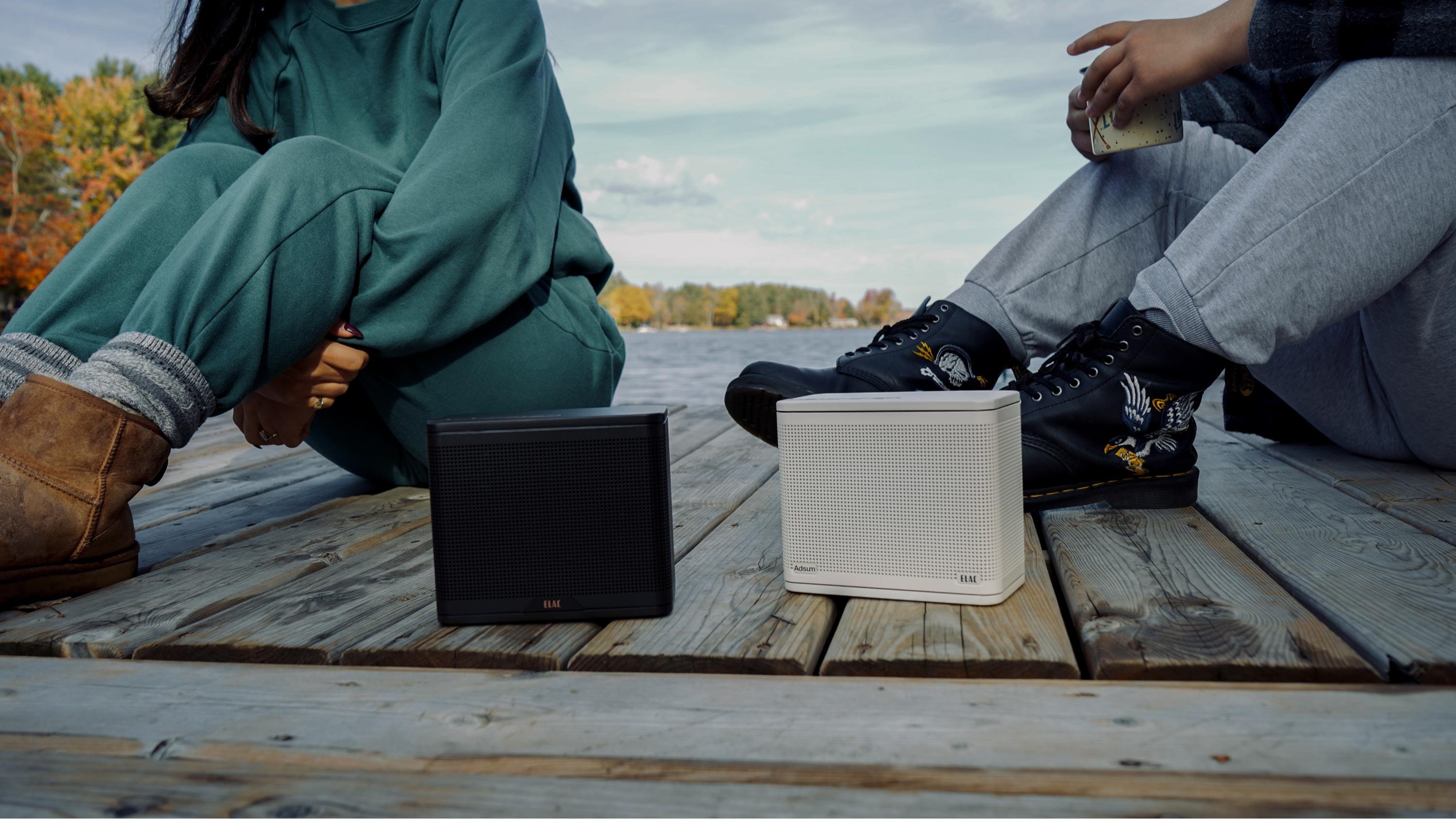What Hi-Fi? Verdict
Obviously the Essence Preamplifier and Stereo from Gryphon are expensive pieces of kit, and it's true that their brutalist aesthetic may not be for everyone. But for those that do indulge, prepare yourself for a tremendously musical and supreme performance.
Pros
- +
Pure class-A sound
- +
Immaculate musicality
- +
Incomparable tone
Cons
- -
Runs very hot
- -
Hefty size and weight
- -
...and price
Why you can trust What Hi-Fi?
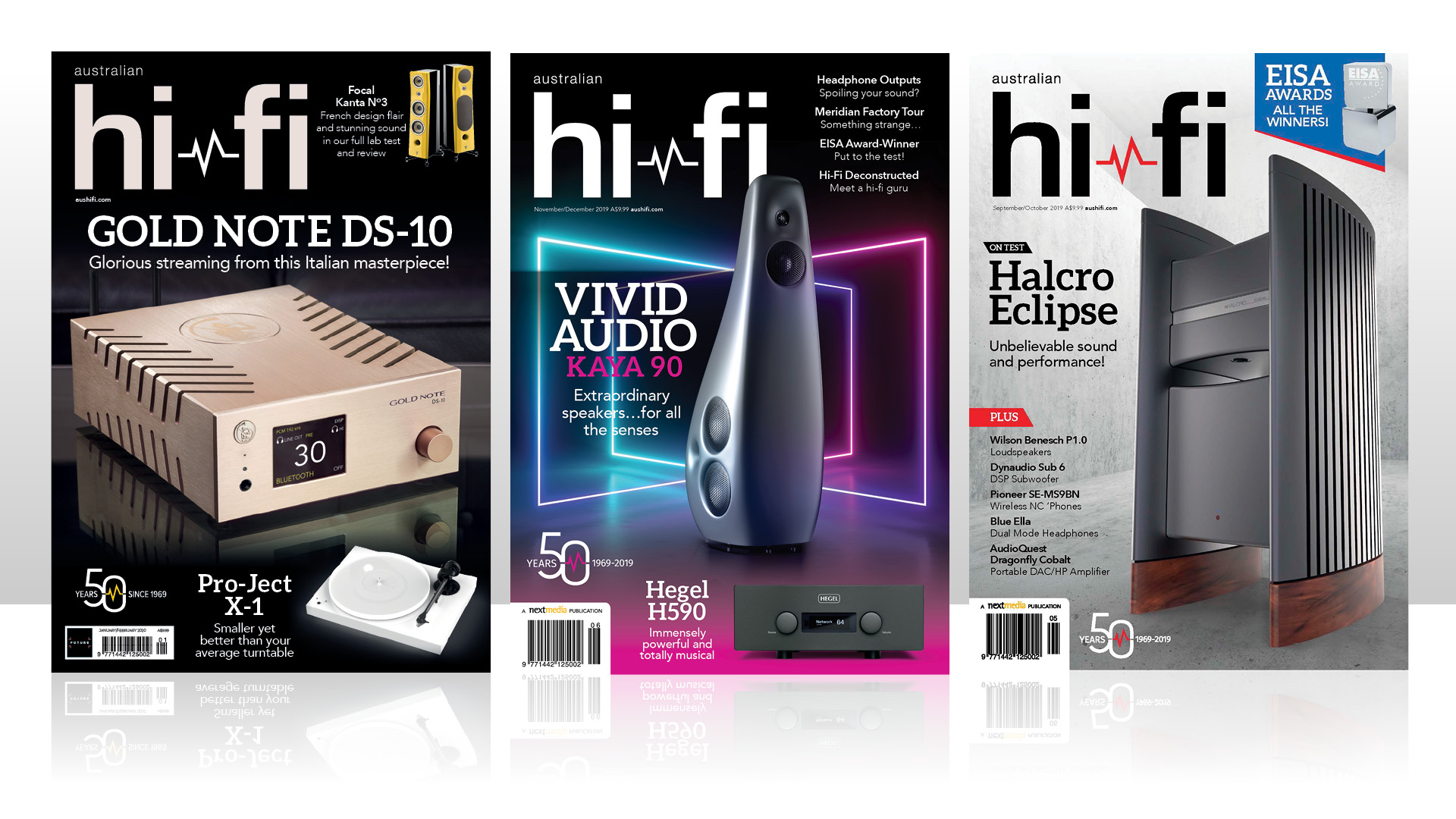
This review and test originally appeared in Australian Hi-Fi magazine, one of What Hi-Fi?’s sister titles from Down Under. Click here for more information about Australian Hi-Fi, including links to buy individual digital editions and details on how to subscribe.
Gryphon Essence Preamplifier tested at AU$26,995. Gryphon Essence Stereo tested at AU$34,995.
The Gryphon Essence stereo power amplifier is a very, very unusual audio amplifier. Which, if you know anything at all about this proudly Danish high-end audio specialist or its recently-retired founder, Flemming E. Rasmussen, should not come as a surprise.
Although Flemming is still associated with Gryphon, the company is now owned by Valdemar Martin Børsting and Gryphon’s employees, which includes electronics designer Tom Møller, who has been the head of the design team at Gryphon for many years now.
The power amplifier is so unusual that it needs an unusual pre-amplifier to drive it, so for this review it is partnered with Gryphon’s Essence Preamplifier. (In point of fact, the Essence power amplifier can be used with any preamplifier at all, but only Gryphon’s preamplifier can take full advantage of the power amplifier’s most unusual feature. Intrigued? You should be!
Gryphon Essence Preamplifier
The Essence has so many unusual and interesting circuit features that it’s actually difficult to know where to start to describe them. The first point to note is that the Essence is a true ‘dual mono’ design, where the left and right channels are completely independent of each other. This is fairly common for power amplifiers (and also true of the circuitry inside the Essence Stereo power amplifier) but it’s actually quite unusual to find in a preamplifier.
The next interesting point to note is that there’s absolutely no signal wiring inside the Essence. The very few wires that are inside it are a short ground lead, some ribbons for the front-panel display and the mains power wires – and even these are contained within shielded channelling.
But perhaps the most interesting feature from a conceptual viewpoint is the Essence’s ‘Green Bias’ link which, when the Essence pre-amplifier is used in conjunction with a Gryphon power amplifier, allows automatic selection of the level of bias applied to the power amplifier’s output transistors.
For information about this, refer to the section of this review titled ‘Green Bias’.
The latest hi-fi, home cinema and tech news, reviews, buying advice and deals, direct to your inbox.
In keeping with Gryphon’s philosophy of maintaining signal purity (which mandates the use of d.c. coupling and eschews the use of global negative feedback), there is no volume control as such.
Gryphon instead uses a microprocessor-controlled 43-step fully-balanced relay-controlled ultra-precision resistor array to attenuate the signal. This works perfectly and is sonically transparent, but has one very small operational quirk, which Gryphon’s Owners Manual explains thusly: “This technology can sometimes – depending on the material played – make a very small clicking noise when used. This is not a sign that anything is wrong and is normal.”
There is no extraneous circuitry inside the Essence. If you want to add a digital stage, or a phono stage, this is achieved by the installation of an additional module. Intriguingly, although two modules are available, you can install only the one or the other of them, because there is only room for one. If you do need both phono and digital inputs, Gryphon suggests that you install the digital module (Zena DAC) and connect Gryphon’s stand-alone Sonett phono stage to one of the Essence’s line inputs, of which there are five – two balanced (using gold-plated XLR connectors) and three unbalanced.
The latter also use gold-plated RCA connectors. In fact Gryphon recommends you connect the Sonett to ‘Input 5’ of the Essence, which is the reason the company has (mis)labelled it ‘RIAA’ even though it’s not a phono input (though I guess it actually is if you install the optional phono stage).
It makes a lot of sense to provide a DAC via a module, rather than integrating it with the rest of a pre-amplifier’s circuitry. The most important reason for doing this is obviously that if you don’t plan to use any digital sources, there’s no sense in paying for digital inputs on your pre-amp (or, indeed your integrated amplifier).
However equally important is that it’s possible to upgrade a modular DAC, with Gryphon itself pointing out that its “future-proof digital module is ready for any current or foreseeable high resolution digital format.”
If you do install the module, which uses an ESS Sabre ES9018 DAC chipset, you’ll find it has five digital inputs: USB, balanced AES/EBU, Optical (Toslink) and two coaxial (BNC). The USB is able to process PCM up to 32-bit/384 kHz as well as DSD (on Windows OS up to DSD512 but only up to DSD128 on Mac). The coaxial and AES/EBU inputs can process up to192kHz/32-bit PCM and the optical input up to 96kHz/24-bit PCM. When the module is installed, the front panel display shows the sampling frequency and format of the incoming digital signal as well as the selected digital filter setting.
Gryphon’s Zena DAC module itself is based on the company’s award-winning Kalliope digital-to-analogue converter and, if it’s not installed at the time of purchase, it can still be added at any time thereafter. The module allows you to select different filters for both PCM and DSD signals. For PCM you can choose between a fast roll-off (long group delay) or a slow roll-off (short group delay). For DSD you can choose between three different –3dB low-pass filter frequencies: 50kHz, 60kHz or 70kHz. As is usual, the DAC will work natively with any Apple computer, but if you use Windows, you’ll need to download drivers from Gryphon’s website.
If you choose to have the phono module (Option PS2-S) installed in the Essence you’ll find that because it is based on Gryphon’s Legato Legacy stand-alone phono stage, it has dual mono circuitry for both its moving-magnet and moving-coil inputs. As with the Zena DAC module, the phono module can be factory-installed at the time of purchase, or installed at any later date. Either way, the module will give you not only multiple options for load impedance for the moving-coil input of 20Ω, 100Ω, 200Ω, 499Ω or 806Ω, but you are also able to insert your own specific-value load resistor in order that you can perfectly match it to your cartridge. The moving-magnet input comes preset with the industry-standard 47kΩ/200pF load.
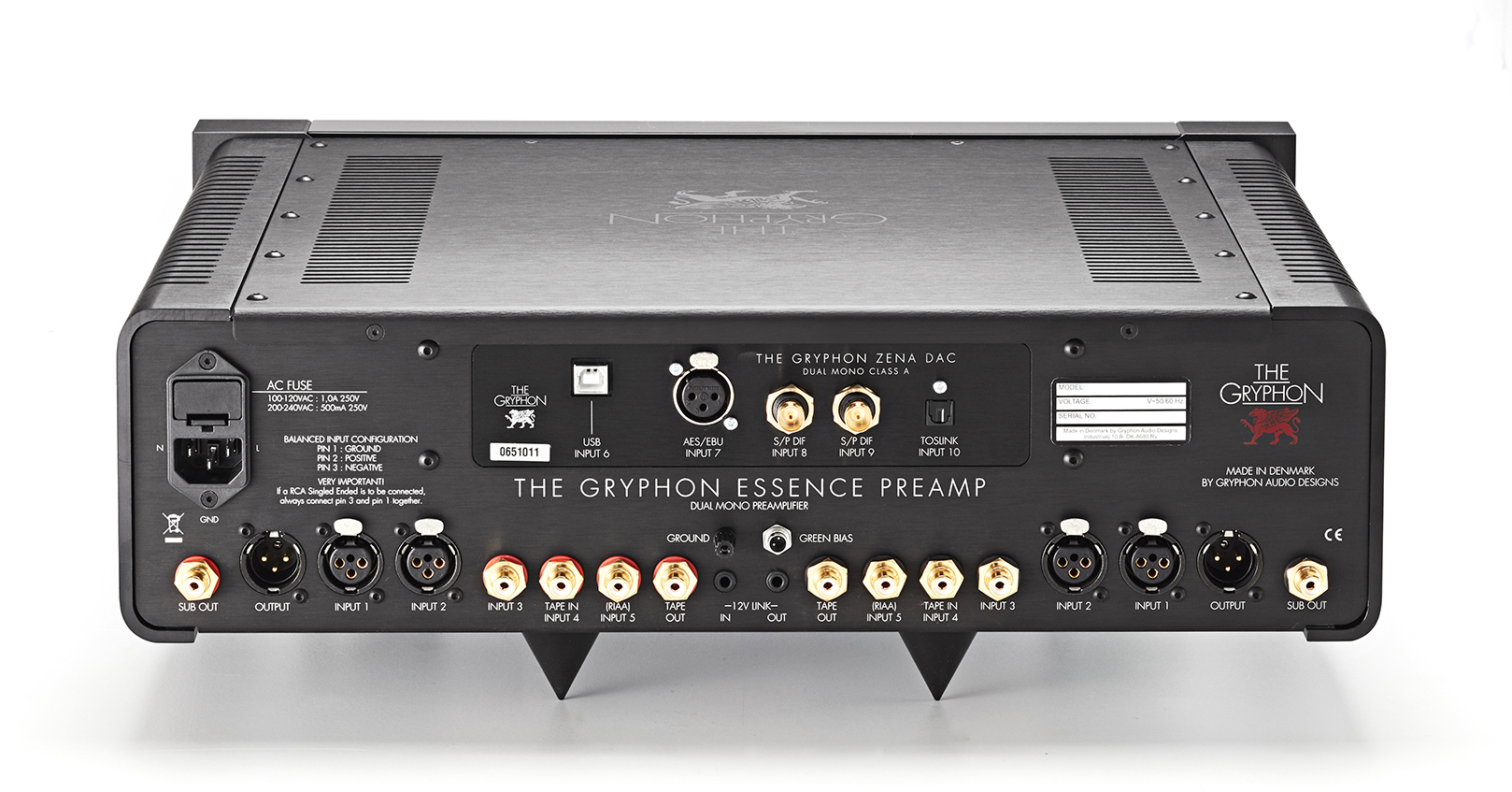
Take a look around the back of the Essence pre-amplifier and you’ll immediately see one outcome of the dual-mono nature of the unit, which is that all the ‘left’ and ‘right’ inputs are at opposite ends of the rear panel, rather than being alongside each other.
I deliberately put the words left and right in inverted commas because Gryphon does not actually label them as such. The terminals are instead identified as Input 1, Input 2 and so on, but of course there are two Input 1s, two Input 2s and so on, the only identifier being that one of the Input 1s is on the left side of the rear panel and the other Input 1 is at the right side.
This means that you will have to pay extra attention to ensure that you don’t accidentally mix up left and right channels when you’re connecting your cables. Speaking of which, Gryphon also manufactures its own cables (Guideline Reference Interconnect) which are colour-coded, which should help avoid any confusion. However, Gryphon has a philosophy about cables – as, indeed, it does about everything involved in audio. It says: “Wires should never be utilised as ‘equalisers’ to correct errors elsewhere in the system. Instead, any error should be corrected at the source, so that interconnects and loudspeaker cables can be selected solely on the basis of sonic neutrality. For this reason, we employ Gryphon’s own range of interconnects and cables at every stage in the design of every Gryphon product.”
The Essence has only balanced outputs (via XLR) presumably on the assumption that anyone who buys an Essence will be using either a Gryphon power amplifier (all of which have XLR inputs) or if they don’t that the amplifier they do use will have them. I’d agree with this assumption.
Rather unusually for a high-end audio-only pre-amplifier, there is a subwoofer output – or, more correctly, there are TWO subwoofer outputs: Sub Out and Sub Out. Note, however, that these are not your usual subwoofer outputs because they’re full frequency-range – in other words, the outputs are not low-pass filtered. So if you don’t use them to connect to a subwoofer you could treat them as pre-amplifier outputs and connect them to any device you want that requires a line-level signal.
Remote control
The peculiarly-shaped remote control supplied with the Gryphon Essence Pre-amplifier is solid metal, so it’s certainly sturdy. It also has two ‘flat’ sides, so you can stand it up on its end, or on its side, both of which orientations can be useful.
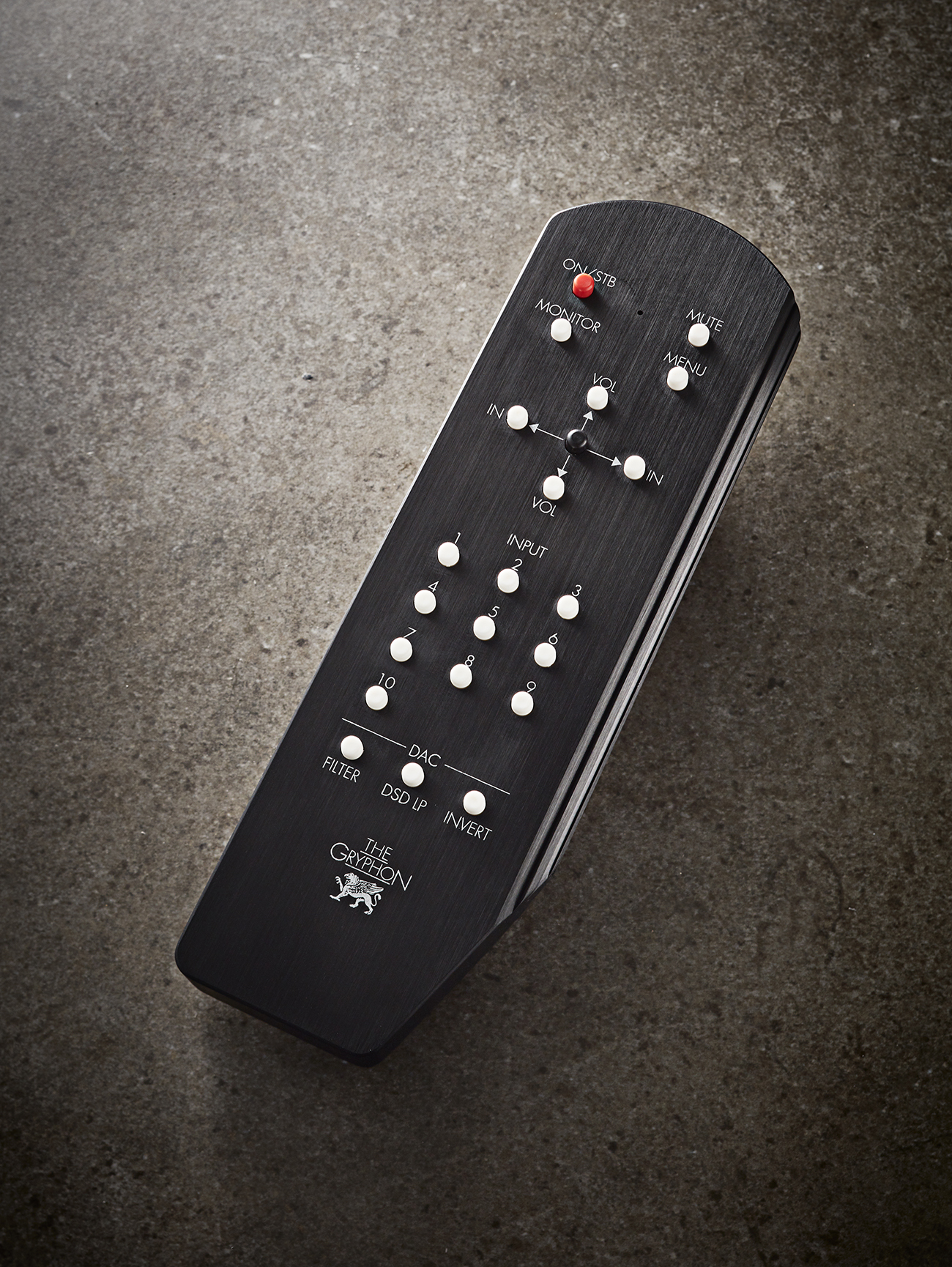
Its underneath is covered by a rectangular section of soft foam, so if you have a delicate surface on which you’d like to place it (a French-polished table, for example) putting it down on its back will ensure the metallic remote doesn’t mark or scratch that surface. And on that – or any other – surface, it will also prevent the remote from sliding, as the foam is quite ‘sticky.’
However, being a foam composition,
I assume that it will deteriorate over time and so will require replacement at some stage in the future. All the buttons are clearly labelled and all operate with a ‘soft’ touch and totally silently: no annoying ‘clicks’ here!
Gryphon Essence Stereo
If I told you that the Gryphon Essence Stereo Amplifier weighs 45 kilograms and is almost half a metre wide and half a metre deep, and a quarter of a metre high, would you care to guess how much power it can deliver to your loudspeakers?
If you’re thinking it might be four or five hundred watts per channel, you’re in for a bit of a surprise: It’s rated at just 50-watts per channel. But that is assuming you have 8Ω speakers. If the impedance of your speakers is 4Ω ohms, Gryphon’s Essence will deliver 100-watts per channel… and if you have 2Ω ohm loudspeakers, it will deliver 190-watts per channel.
This power output is managed by 10 Sanken bipolar output transistors per channel. (Interestingly, Gryphon’s Essence Monobloc power amplifier has 20 of these same devices, which enables slightly higher power output into 2Ω, even though it delivers exactly the same power as the Essence Stereo into 8Ω and 4Ω loads.) The separate driver section has its own power supply, delivered from individual windings of the custom-made toroidal transformers.
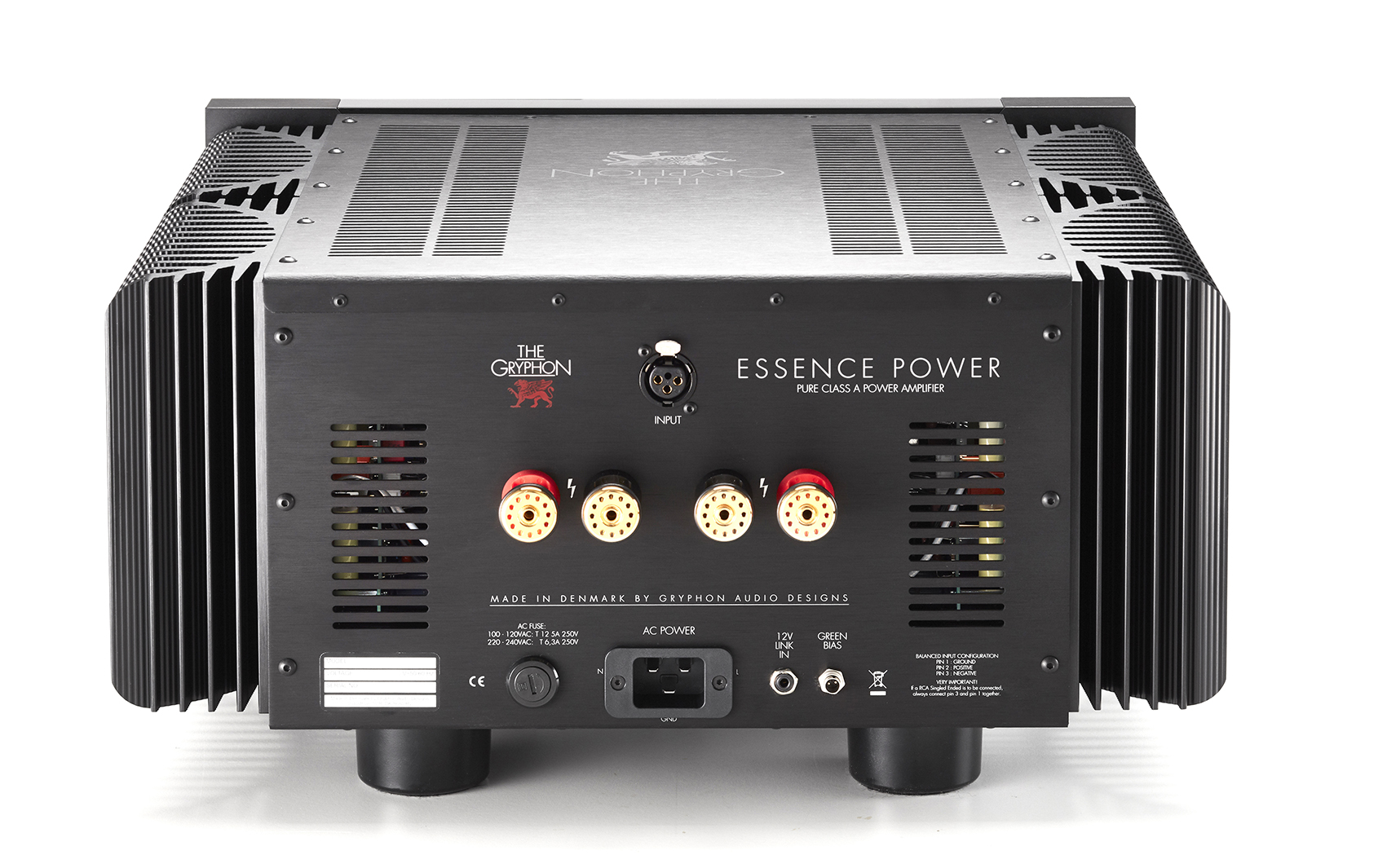
Green Bias
To understand what Gryphon’s ‘Green’ biasing system does, you need to understand just a little about how audio amplifiers work. Basically, in order to ‘amplify’ an audio signal we need to use a special type of semiconductor called a transistor which allows you to use a low voltage (the input) to control a much higher voltage (the output). This means that the word ‘amplify’ is something of a misnomer because it’s not actually making the low voltage signal any bigger, it’s just making a different, higher-voltage signal increase and decrease in perfect unison with the low-voltage signal.
Various different types of solid-state devices have been invented to do this. The most common of these is the bipolar junction transistor (BJT). Another common one is the metal oxide semiconductor field effect transistor, or MOSFET. Because transistors can only handle a fairly small amount of power, multiple transistors are required to be connected together in order to achieve high power output levels.
When using multiple transistors, they can also be connected together in different ways, called ‘Classes’. We’re only going to deal with three of them here in this review: Class-A, Class-B and Class-AB.
In a Class-A amplifier, the transistors handle 100 per cent of the audio signal, so they conduct though the full 360 degree sinusoidal waveform. This means that the transistors are working at their maximum capability, which means they draw maximum power and generate maximum heat.
To avoid this, amplifier designers came up with a Class-B design, where two different transistors were used. One transistor handled the first half-cycle of the audio signal from (0 to 180 degrees) and the other handled the second half-cycle, (from 180 degrees to 360 degrees), after which it’d hand the audio signal back to the other transistor. Whilst-ever one transistor was ‘on’ the other one was ‘off.’ There were two problems with this system. The first was that you had to use one type of transistor for the 0–180° part of the cycle, and a completely different type of transistor for the 180–360° part, and the two different devices have different electronic characteristics.
The second, bigger, problem with this arrangement was that transistors cannot switch instantly, so there was always a ‘glitch’ at the point of switching which created so much distortion this circuit could not be used for amplifying audio signals. This is where Class-AB comes in.
In a Class-AB amplifier, each transistor conducts for more than 180 degrees, so there’s an overlap that effectively eliminates the switching glitch.
If you make the overlap quite small you are able to reduce the cost of the amplifier by having a smaller power supply, less expansive heat-sinking and a reduced number of output transistors. But there will still be a small glitch when the audio signal changes from one transistor to the other.
This can be partially overcome by increasing the size of the overlap, but of course as you increase the amount of overlap you also have to increase the size of the power supply, the area of heat-sinking and add additional output transistors.
The amount of overlap is determined by the amount of bias voltage you apply to the transistors. If you use a low bias, the amplifier will operate in Class-A mode up to a certain set power say, 10-watts, before switching to Class-AB. Let’s call this Amplifier X. If you use a higher bias, the amplifier will operate up to 20-watts in Class-A before switching to Class-AB. Let’s call this second amplifier Amplifier Z.
In the scenario described in the previous paragraph, so long as you listen at a volume level that requires these two amplifiers to deliver less than 10-watts, you’d be hearing ‘Class-A’ sound all the time from both amplifiers. If, however, you turn up the volume, so you’re listening at a constant level of 15-watts, Amplifier X would be operating in Class-AB mode while Amplifier Z would still be operating in Class-A mode.
With the Essence amplifier (as with several other of its amplifiers) Gryphon allows you to select the level of bias you’d like to use (and therefore the amount of power that will be delivered in Class-A mode). Firstly, there’s a manual selection on the Essence power amplifier, which has positions for ‘Low Bias’ and ‘High Bias’. If you use the ‘Low Bias’ mode the amplifier will be more economical to run, but will switch from Class-A mode to Class-AB at a lower level than if you select the ‘High Bias’ mode.
If you choose the ‘High Bias’ setting, the amplifier will operate entirely in Class-A mode, but will become very, very hot and be very expensive to run.
However, if you select the ‘Green’ mode, and link the ‘Green Bias’ terminal on the Gryphon pre-amplifier to the equivalent terminal on the Essence power amplifier, the power amplifier will select the bias level automatically, which it calculates using an algorithm that’s based on the position of the pre-amplifier’s volume control.
Using this mode enables Gryphon to offer a third (Medium Bias) mode in addition to the Low Bias and High Bias modes and vary when the mode will change. Choose one scenario and the Low Bias will apply for volume settings from 00 to 09, Medium Bias for 10 to 19 and High Bias for 20 to 42.
Choose the other scenario and Low Bias will be applied for volume settings from 00 to 15, Medium Bias for settings from 16 to 25, and High Bias for settings from 26 to 42.
It’s a very clever design and a very convenient one for listeners. It will also help save the planet… hence the use of the word ‘Green’ before the word bias!
I should note that there is some disagreement about what constitutes a ‘Class-A’ circuit design – even amongst amplifier designers. Some designers claim that the only ‘true’ Class-A circuit is one where only a single semiconductor is used to produce the audio signal, and that there can be no ‘sharing’ of the audio signal between different semiconductors. The designers who hold this view would say that while Gryphon’s Essence is a Class-A design, it’s not a ‘true’ Class-A design because it uses multiple output devices. This is such an arcane difference that the only people arguing it should be those who have a degree in electrical engineering!
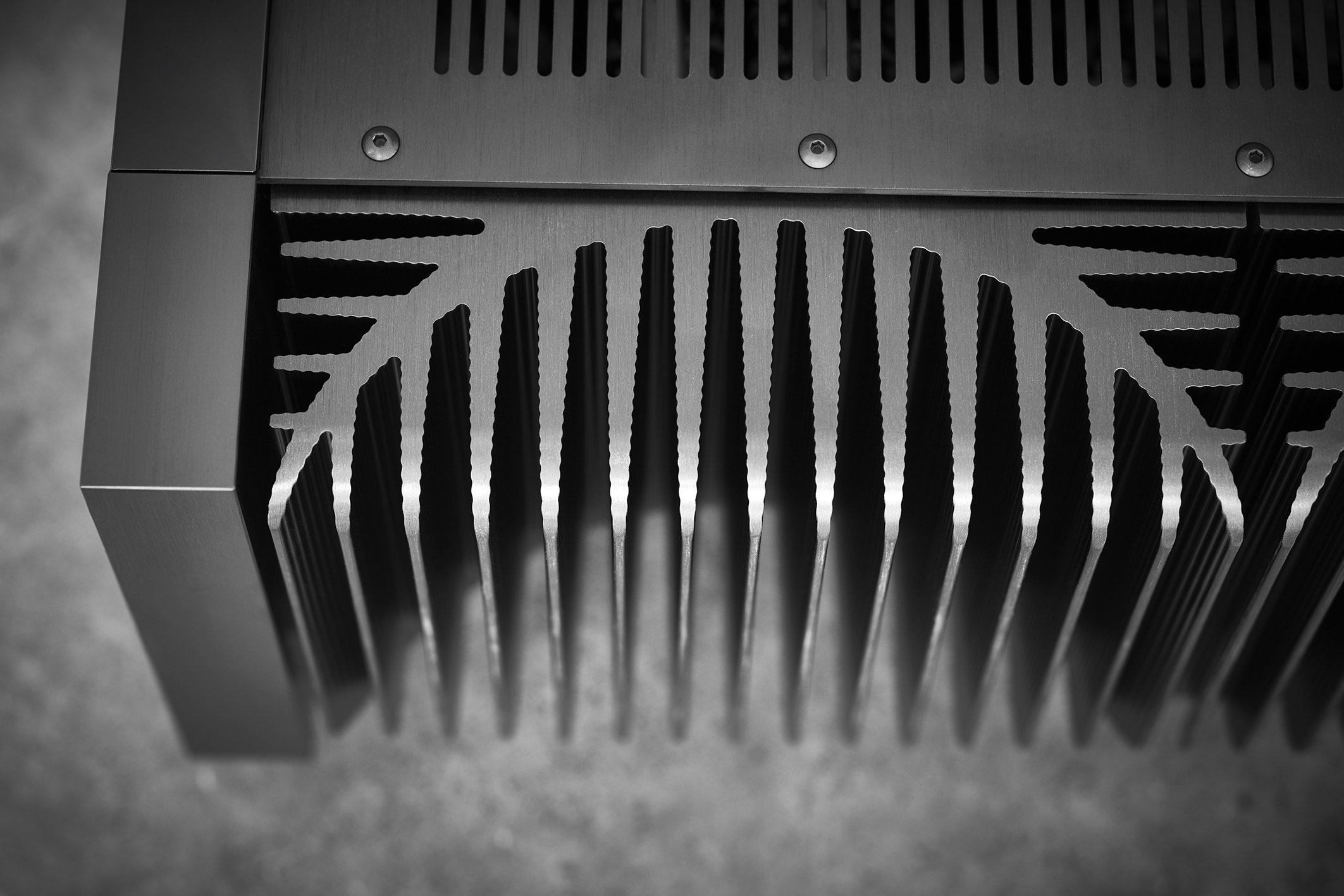
Auditions
Although you might imagine given Gryphon’s minimalist philosophy – and the lack of a balance control or tone controls – that its Essence pre-amplifier would offer no user niceties, nothing could be further from the truth. What you will discover if you explore the menu options on offer is that the Essence has some very cool – and very useful – features.
For my money, the most useful of these is the Essence’s input level matching circuitry, which allows to to adjust the gain of the amplifier so that whenever you switch from one input to another, you will hear exactly the same volume level, irrespective of the signal level at that input. Unlike most such circuits, which introduce additional components into the signal path in order to accomplish this end, Gryphon does this by storing the offset values in the microprocessor that controls the resistor attenuator network, thereby ensuring the purity of the audio signal. This is really clever!
My next favourite circuit is actually two closely-related circuits, ‘Start-Up Level’ and ‘Maximum Level.’ Their names describe what they do, in that you can set a start-up volume level that will be applied automatically whenever you switch the pre-amplifier on, while the maximum level circuit allows you to set the maximum volume at which your system can be played.
The number of volume levels you can use, however, is fairly restricted, because the minimum volume level is 00 and the maximum is 42, so there are only 42 different settings. I’m going to guess that the reason for 42 being the maximum level is because Gryphon’s designer is a fan of Douglas Adams and his book Hitchhiker’s Guide to the Galaxy, in which the computer Deep Thought says the answer to the question of the meaning of ‘life, the universe, and everything’ is 42.
However, it might equally be that 42 was the last number for which the Diophantian equation was solved. There are 42 other good reasons it could be 42 too.
Unlike some similar systems I have seen, the maximum level you set on the Gryphon cannot be over-ridden without using the remote control, so once you’ve programmed in a maximum volume level it cannot be exceeded unless you re-program the max level circuit, a process that requires the use of the remote control. This means that if you lock your remote control away somewhere, no-one can mis-use your system, yet they can still actually use it. Again, very clever!
Adjusting volume via the front panel or the remote control will defeat the muting circuit, which is exactly as it should be, though I think it would have been more elegant if adjusting volume upwards defeated the mute, but adjusting it downwards didn’t. Switching inputs, incidentally, does not defeat the muting circuit: the amplifier will remain muted when you switch from one to another. (The mute indicator is an icon of a speaker followed by an ‘x’.)
I also liked the fact that the Gryphon Essence pre-amplifier lets you change the standard input names that are displayed in on the front panel (CD, DVD, DSD, Tuner, Tape, Phono, DAT, DAC, Stream and Aux) to anything you want… though the eight character limit might mean you have to be a bit creative in your input-naming procedure. This is nice, but lots of manufacturers do this, so the only surprise is that it’s on a high-end device. Most high-end manufacturers eschew such pedestrian niceties.
And for those who don’t like bright displays, which includes me, you can dim the display to 75% of its normal level, 50% or 25%. And if you really, really don’t like displays at all, you can have it turn it off completely, though it will briefly turn on (for less than fifteen seconds) whenever you use a function so you can ascertain the operational status of the amplifier. In a rather sensible move, a small blue LED comes on whenever the display is off, so you will never accidentally leave the amplifier switched on when you’d prefer that it was off. And when might you prefer that it was switched off? I’d suggest that should be any time you’re not using it, even if you are using the Green Bias mode. The display itself isn’t state-of-the-art, rather a fairly old-fashioned dot-matrix type, albeit a fairly high-density one.
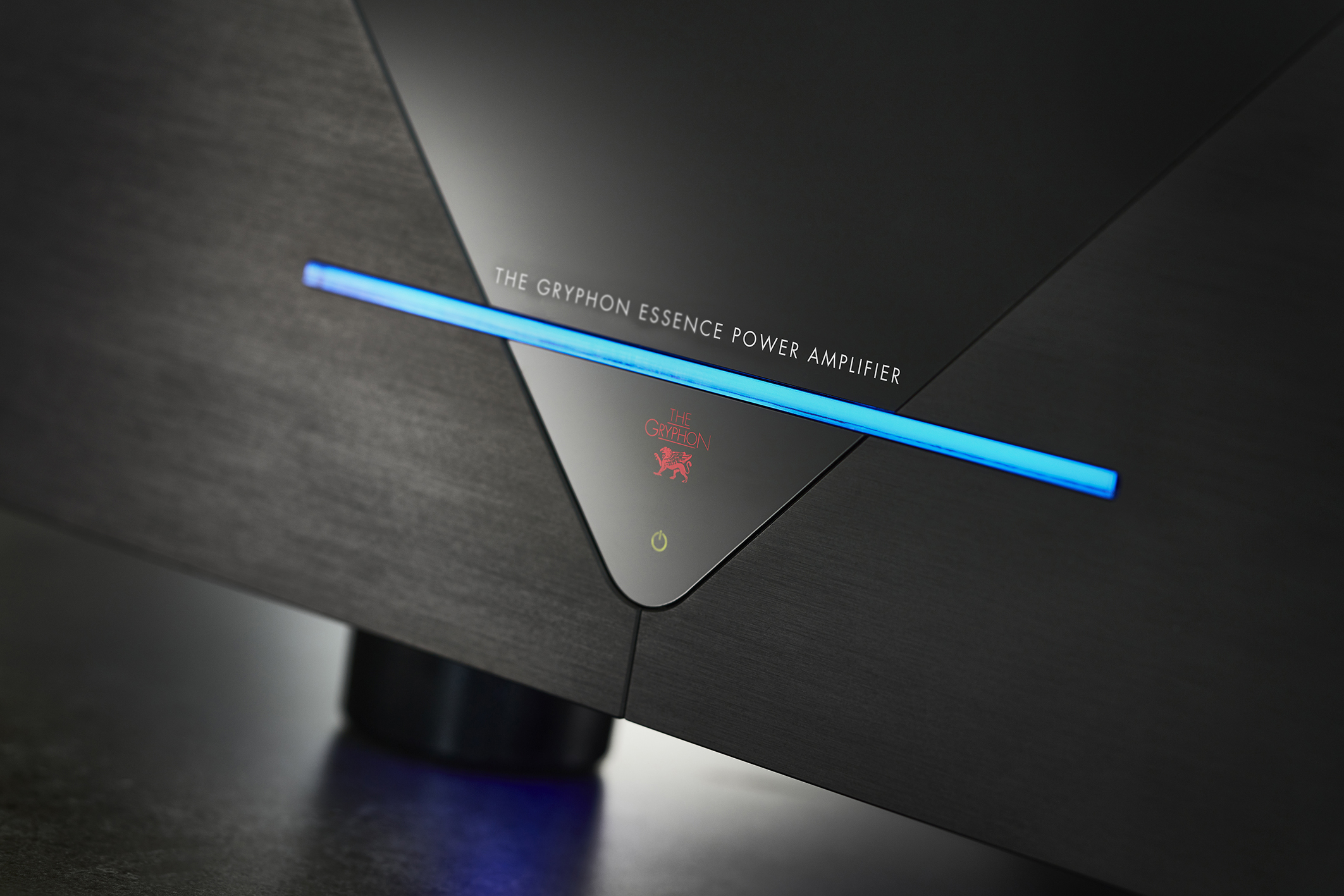
The first music that I heard delivered by this Gryphon Essence Pre/Stereo duo was from ex-pat Daniel Thorne. Now based in England, his first solo album, Line of Sight, is absolutely glorious. Though it’s the last track on it, I generally play Fear of Floating first, because (a) I like it the most and (b) I can never quite get over how realistically Thorne’s sax is recorded, and when I listened to it with the Gryphons I heard it more realistically than I ever had before. Whereas with lesser amplification I might never be quite sure I was hearing the sound of the pads landing on the edges of the tone-holes, I was left with absolutely no doubt when listening via the Gryphons.
As for the Gryphons’ ability to sound-stage, for that I used Thorne’s spooky Pyriscience, which would be an excellent basis for the theme music of a science-fiction movie. The absolutely grounded way the Gryphons delivered the continuous bass sound while simultaneously suspending the almost supra-audible high-pitched keening treble was an object lesson in control. When I closed my eyes I found that the eerie soundscape was almost surround-like in its ability to envelop me in sound. Truly amazing for both the track and the amplification chain.
It is often difficult to explain how a superior amplifier can correctly deliver the emotion that caused a song’s creation, but if you listen to Nine Inch Nails’ Right Where It Belongs with this Gryphon pair, you will know immediately that it’s delivering emotion in its truest form. When the final, sad and solo notes die out from that out-of-tune piano, I guarantee you’ll just hit the play again button over and over… and over. This represents stunning presentation from the Gryphons. Few amps can do this.
And while we’re talking Trent Reznor, why not use Closer as a taster for the insane ability of the Gryphon duo to deliver deep bass. His bass drum sample (originally from Iggy Pop’s Nightclubbing, but so heavily modified you’d never know… unless you did) was crushingly powerfully delivered, no matter how high high I cranked up the volume. (Warning, you should not watch the video version of this song if you are squeamish or are in any doubt of your own sanity).
Piano is a great revealer of sonic inadequacies, and you won’t hear any sonic inadequacies at all if you audition Jon Hopkins’ extraordinary third studio album, Insides. Even if you don’t know him, you’ve probably heard his collaborative work, for example on Coldplay’s Viva La Vida which features Hopkins’ song Light Through the Veins. His style has been called ‘sophisticated ambient electronica’ because of his superb pianism, his classical training and his talent for complex composition.
Light Through the Veins is one of the tracks on Insides, but do make sure you listen to Vessel, with the overdubbed piano and the house music. As well as listening to the piano sound across its octaves, you’ll also be able to hear the tonality of the performance of the Gryphon duo (and stretch the capabilities of your loudspeakers) as the music digs deep into the lowest frequencies. You can also admire the clarity of all the buzzes, beeps and sound effects as delivered by this Gryphon pair.
If you audition the Gryphon duo with a more conventional piano and pianist, such as Australia’s own Stephanie McCallum, you’ll find the same applies. I listened to a favourite of mine, her album Perfume, which obliquely references the fact that on it she plays works by French composers.
The composers whose works she plays include Debussy, Satie, Faure, Ravel, Saint-Saens and others. I was going to write ‘famous’ French composers in that previous sentence except that she also plays works by Alkan, Ropartz and Chabrier, none of whom are exactly household names unless you’re a pianist or seriously into classical compositions.
Of course the Debussy she plays is Clair de Lune, which is one of the reasons this is one of her most popular albums, and a best-seller for ABC Classics (and her, of course). An acclaimed French music specialist, McCallum gave what is believed to be the first complete public performance of Alkan’s Three Studies, Opus 76 (for the Left Hand, for the Right Hand, and for the Hands Reunited).
As you’d expect of her, her piano, her piano tuner and ABC Classics, the sound quality on this album is as glorious as her performances of all the works on it, and the Gryphons revealed to me the intimacy of the recorded acoustics, the sonorities of the piano, and the delicacy of her playing, all of which enabled me to reach that holy grail of hearing the very essence of the music.
Over the course of my listening sessions I tried the Gryphon’s various bias settings and can recommend that if you use these as a pair, you should most definitely avail yourself of the ‘Green Bias’ setting, but if you are using the Gryphon Stereo on its own, then the ‘High Bias’ setting is the one to go for – but only if you make sure there’s adequate ventilation to take care of the inevitable heat build-up because, as with all Class-A designs, after a while the Essence power amplifier gets very, very hot!
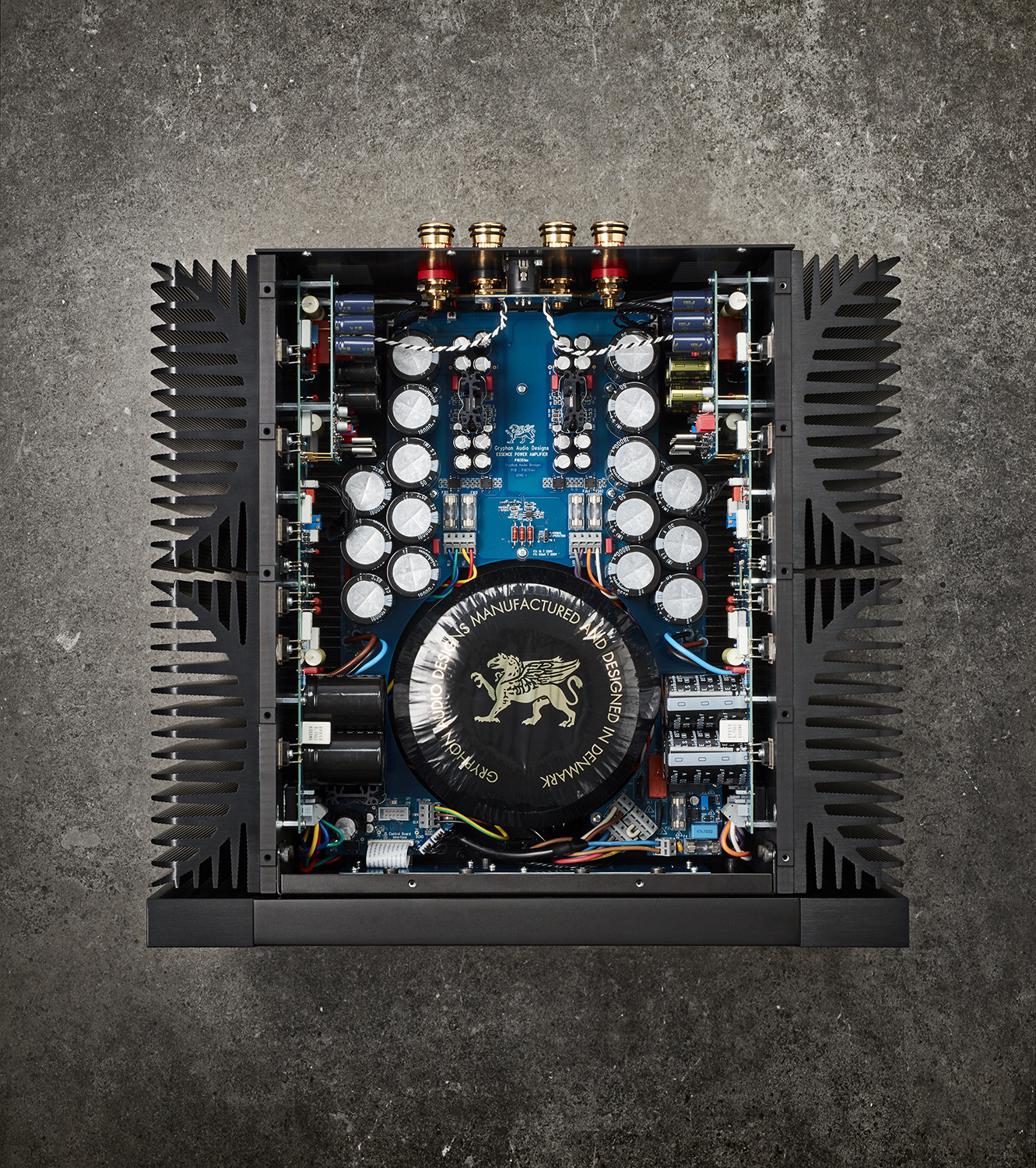
Final verdict
The exterior aesthetics of Gryphon’s amplifiers may not appeal to everyone, being somewhat ‘brutalist’ – if I can use that word in its most architectural sense – in appearance, but the sound quality will have instant appeal, no matter what genre of music you prefer to listen to.
Gryphon goes into many technicalities when it’s describing how its amplifiers are designed, and how those designs are executed, but there’s no single individual element that can explain why these particular amplifiers perform at the spectacularly high level that they do.
And perhaps we should not even be wondering about this, or trying to explain it. Whilst I was listening to Clair de Lune, I was reminded of something Claude Debussy once said: “We should be constantly reminding ourselves that the beauty of a work of art is something that will always remain mysterious; that is to say one can never find out exactly ‘how it is done’. At all costs let us preserve this element of magic peculiar to music. By its very nature music is more likely to contain something of the magical than any other art.” So in order to help preserve the magic that is the Gryphon sound, I shall say no more.
Laboratory test report
Newport Test Labs measured the power output of the Gryphon Essence Stereo power amplifier at exactly 51-watts per channel into 8Ω at all audio frequencies and irrespective of how many channels were driven: one or both. When driven into 4Ω loads, the Gryphon Essence’s power output doubled, which is exactly what a ‘perfect’ amplifier should do, but so few actually really do when tested. Again, the output was exactly 102-watts per channel at all audio frequencies irrespective of how many channels were driven, as you can see from both the accompanying bar graphs and the tabulated chart.
The Gryphon Essence very nearly pulled off the same trick again when Newport Test Labs dropped the load resistance to just 2Ω, but instead of delivering the theoretical ideal of 204-watts, the amplifier’s output instead topped out just four watts shy of that figure, delivering exactly 200-watts per channel, again at all audio frequencies and irrespective of the number of channels driven. Although this figure was just short of the theoretical ideal, it was bang-on Gryphon’s specification.
I need to emphasise at this point that these are absolutely fantastic results for a Class-A amplifier stage. It is an extraordinarily hard task for any amplifier designer to build a Class-A amplifier that will do this… just ask two of the world’s pre-eminent amplifier designers, Doug Self or Nelson Pass!
The frequency response of the Gryphon Essence pre/power duo was excellent, and remember that this is the response for both the pre-amplifier and the power amplifier combined, not individually, which is how the manufacturer lists the specifications. As you can see from the tabulated figures, Newport Test Labs measured the frequency response at less than 1Hz to 113kHz –1dB, and at less than 1Hz to 217kHz –3dB. Once again, this is outstandingly good performance.
Graph 1 shows the frequency response between 20Hz and 50kHz (again with both the pre and power amplifiers in the test loop) when driving a standard laboratory test load (an 8Ω non-inductive resistor) and when driving a load that simulates the one that would be presented by a two-way bass reflex loudspeaker (Newport Test Labs uses the same load for this test as Stereophile magazine: a load designed by Ken Kantor that John Atkinson modified to include Zobel impedance compensation in the treble).
The black trace on this graph shows the frequency response into a standard 8Ω non-inductive when the amplifier is in Class-A mode, while the red trace shows the frequency response using Class-AB mode into the same load. You can see there’s a very slight sag centred around 50Hz with the high-frequency response ‘rolling off’ at around 4kHz, with the Class-AB mode rolling off a little earlier than the Class-A mode.
Note that when I say ‘rolling off’ you need to bear in mind the vertical scale of the graph, where the top is +0.5dB and the bottom is –0.5dB, so the Class-AB mode’s frequency response is actually a mere 0.75dB down at 20kHz and only 0.18dB down at 40kHz! This puts the normalised frequency response of the Gryphon pair across this band as 5Hz to 40kHz ±0.09dB. On any normally-scaled graph, both traces would be flat lines and indistinguishable from each other.
The blue and purple traces on Graph 1 show the Gryphon Essence pair’s response into the simulated load, again for the Class-A and Class-AB modes respectively. As you’d expect, there’s more variance in the response, but this variance is again exaggerated by the extreme vertical scale of the graph, so that overall, the normalised response into this load using the Class-AB mode is 5Hz to 40kHz ±0.15dB. Again, on any standard graph, these two traces would almost be straight lines, such that all four traces would be almost indistinguishable from each other (which is why Newport Test Labs selected a more expanded scale than usual).
Although it’s apparent from Graph 1 that performance in the Class-A mode is superior to that in Class-AB the actual differences in level are so small that they would be imperceptible to the human ear.
The balance between the two stereo channels of the Gryphon Essence duo was measured by Newport Test Labs as 0.002dB, which would be a stunningly good result at any time, but even more so when you consider the dual mono nature of the designs. I am amazed at such a good result.
Channel separation, as you can see from the tabulated figures, is in triple digits for all three test frequencies, with measured results of 107dB at 16Hz, 111dB at 1kHz and 104dB at 20kHz. These are, self-evidently, all excellent results. However, given the dual mono nature of the design, I would not have expected any less. The interchannel phase results (also tabulated) were not quite as good as I might have expected, particularly at 20kHz, but are excellent nonetheless. These would be affected by cable choice, and the lab was not using Gryphon’s own cables, so this would also be a factor.
Newport Test Labs has shown distortion test results for the usual output power levels of 1-watt and 20-watts into both 8Ω and 4Ω test loads, using a 1kHz test signal for both Class-A and Class-AB modes and, as you can see, Class-A mode resulted in less distortion in every test.
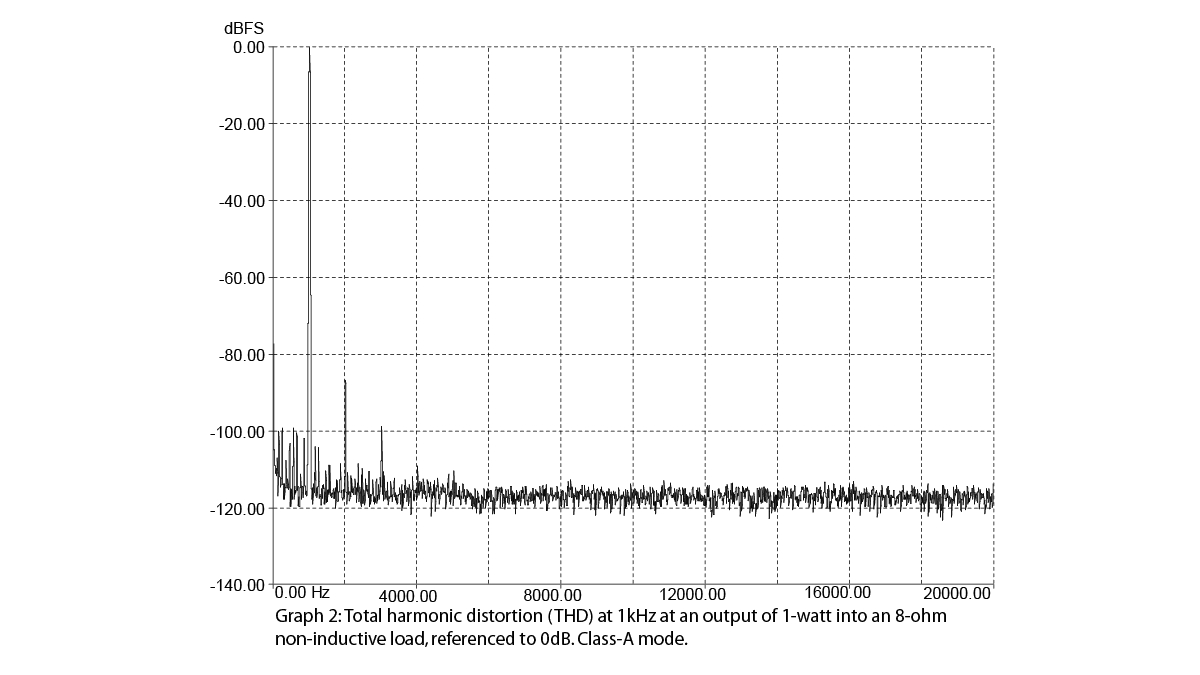
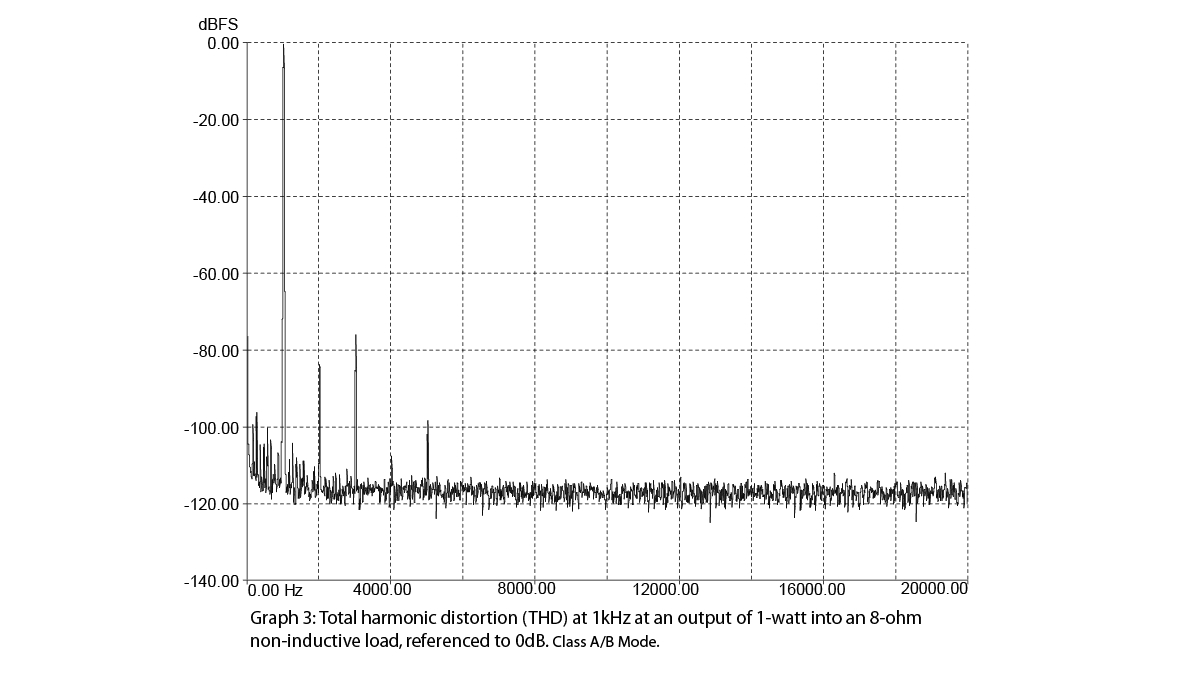
Graphs 2 and 3 show output at 1-watt into 8Ω for Class-A and Class-AB modes respectively. You can see that in Class-A mode there are two primary harmonic components, a second at –87dB (0.00446%) and a third at –98dB (0.00125%). There’s a fourth at –111dB (0.00028%) and a fifth at –112dB (0.00025%) but both these are essentially buried in the noise floor.
In Class-AB mode you can see that the levels of the second and third harmonics have increased, to –84dB (0.00630%) and –77dB (0.01412%) respectively with the third harmonic predominating. This is important because all things being equal, second harmonic distortion ‘sounds better’ than third harmonic distortion, although both are actually euphonious, being the octave and the fifth. You can also see that the fourth and fifth harmonics are now clearly clear of the noise floor, at –109dB (0.00035%) and –98dB (0.00125%) respectively.
When output load is reduced to 4Ω, the distortion spectrum when the amplifier is in Class-A mode (Graph 4) is very similar to that when it’s driving an 8Ω load, however, in Class-AB mode there’s a substantive difference, particularly in the higher-order harmonics, with sixth and seventh-order components at –112dB (0.00025%) and –97dB (0.00141%). Sonically, distortion components become less benign as their frequency gets higher, so low-order distortion components are always to be preferred to high-order.
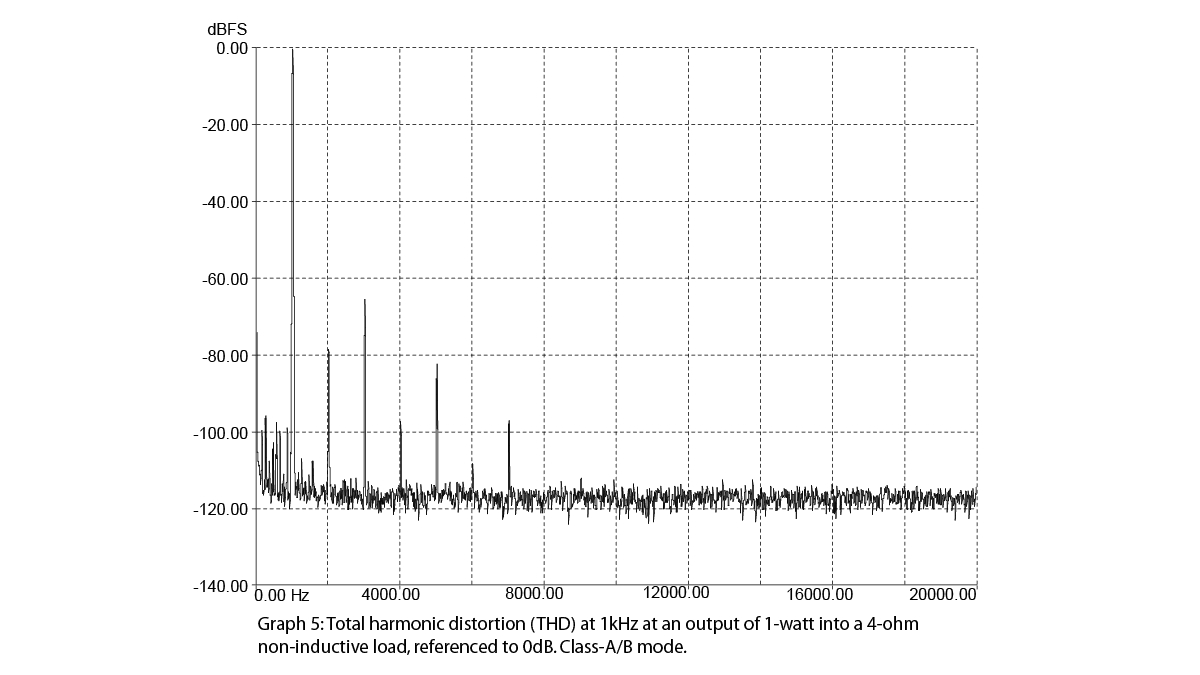
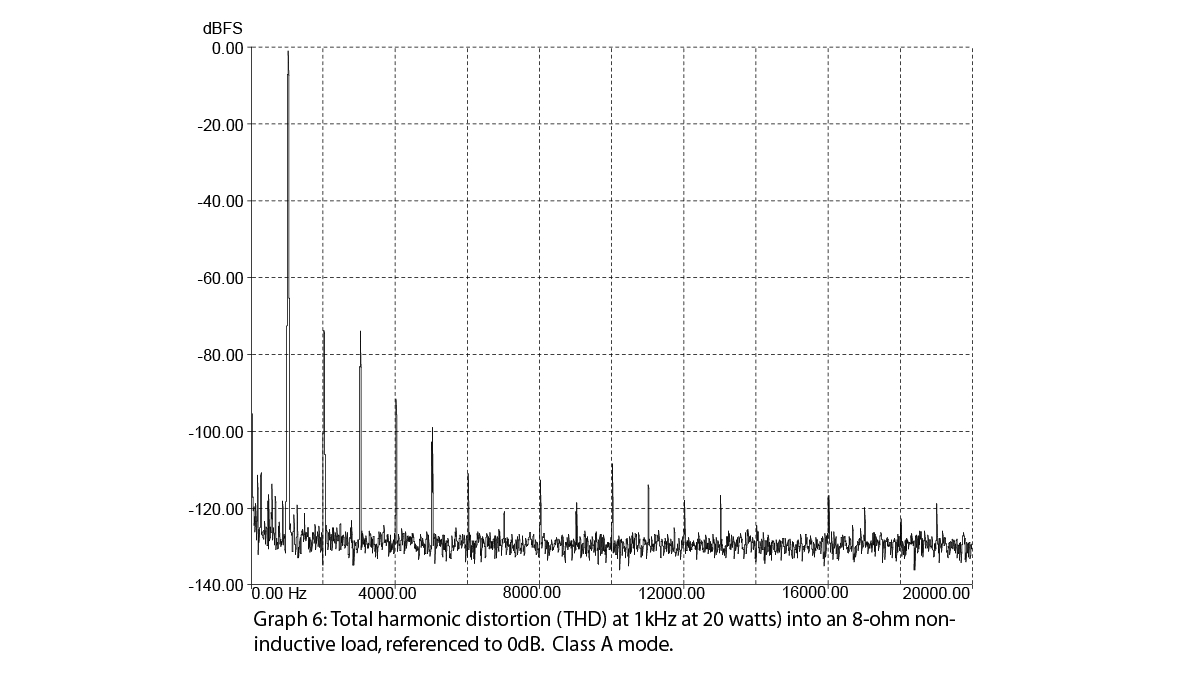
Distortion increased as power output increased, as I’d have expected. Graph 6 shows that when the Gryphon was delivering 20-watts in Class-A mode into 8Ω second- and third-order harmonics were both at close to –75dB (0.01778%), plus there was a fourth at –92dB (0.00251%), a fifth at –99dB (0.00112%) and a sixth at –110dB (0.00031%). All other harmonics visible on this graph are close to or more than 110dB down.
When driven into 8Ω using Class-AB mode at 20-watts (Graph 7) distortion increased across the board, plus the predominance of the odd-order harmonics (3rd, 5th, 7th, etc) at fairly high levels becomes very marked.
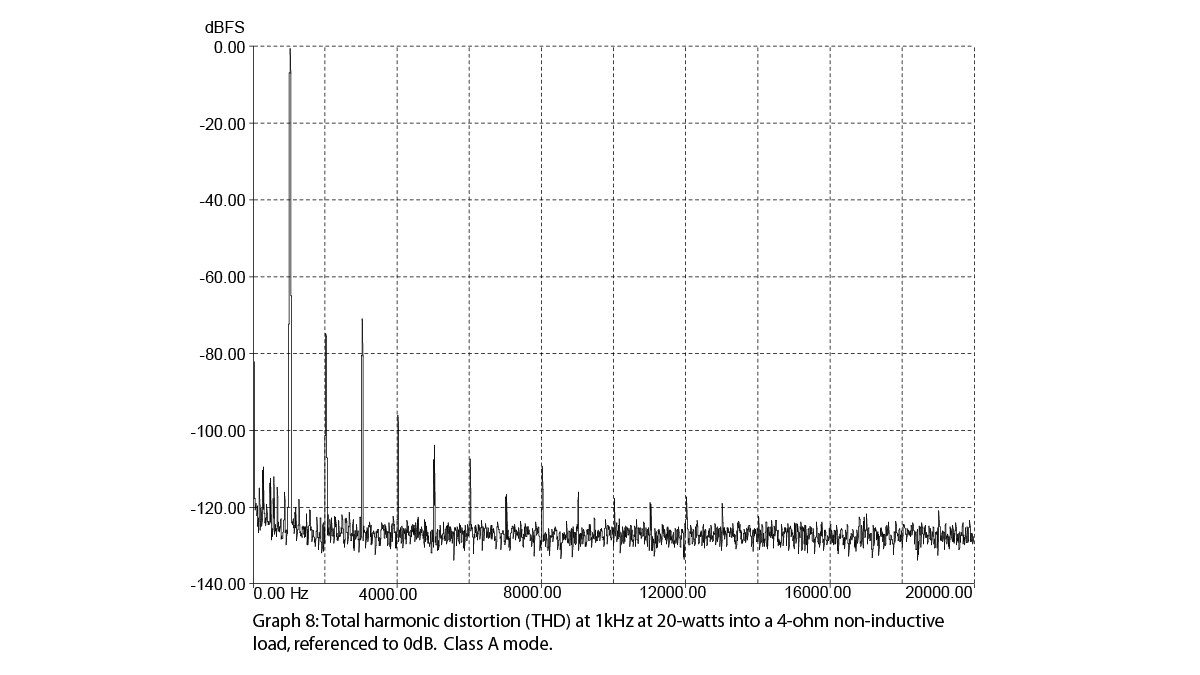
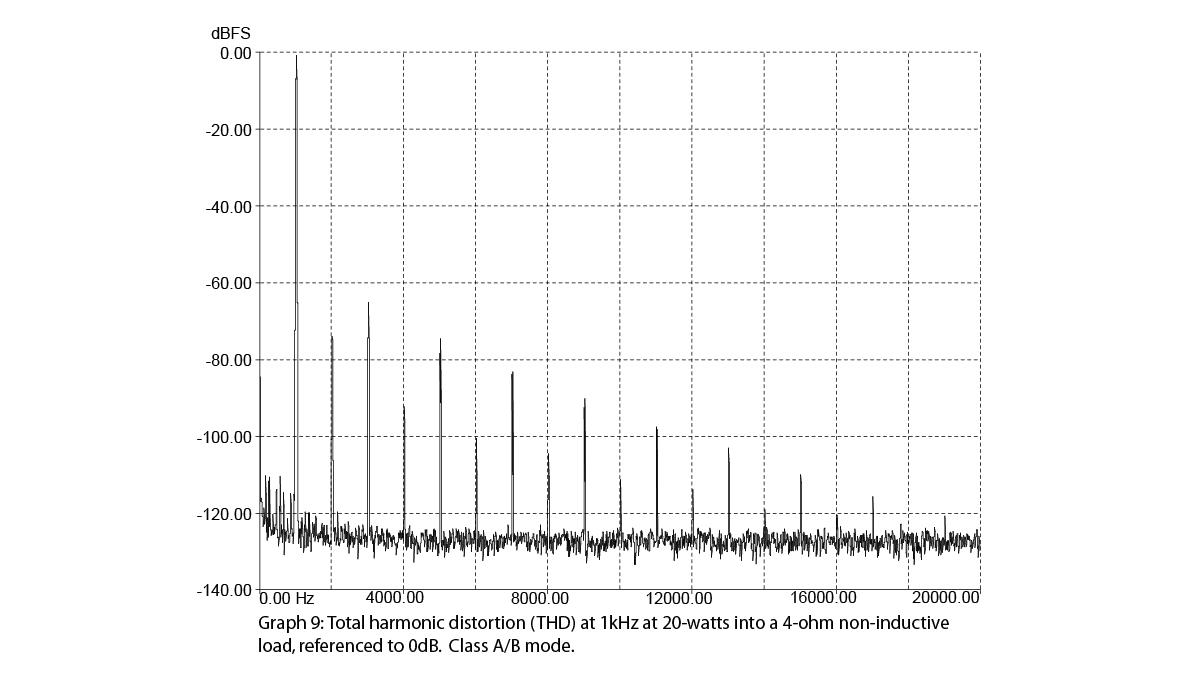
This disparity becomes even more obvious when the load impedance is reduced to 4Ω, as in Graphs 8 and 9.
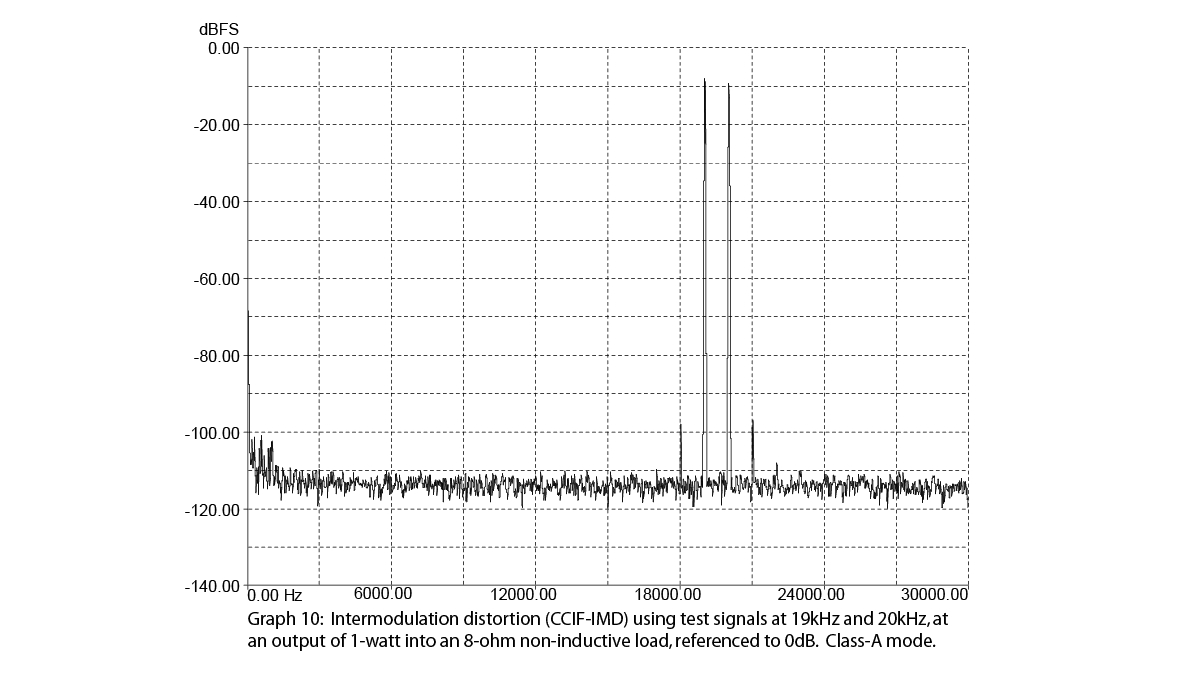
Newport Test Labs’ measurements not only showed that intermodulation distortion (IMD) was also lower in Class-A mode than in Class-AB mode, but also that it was particularly low in Class-A mode, as you can see in Graph 10. There are only two sidebands accompanying the test signals and both are down around –98dB (0.00125%). There’s no obvious difference signal down at 1kHz but if there is, it’s down at around –112dB (0.00025%).
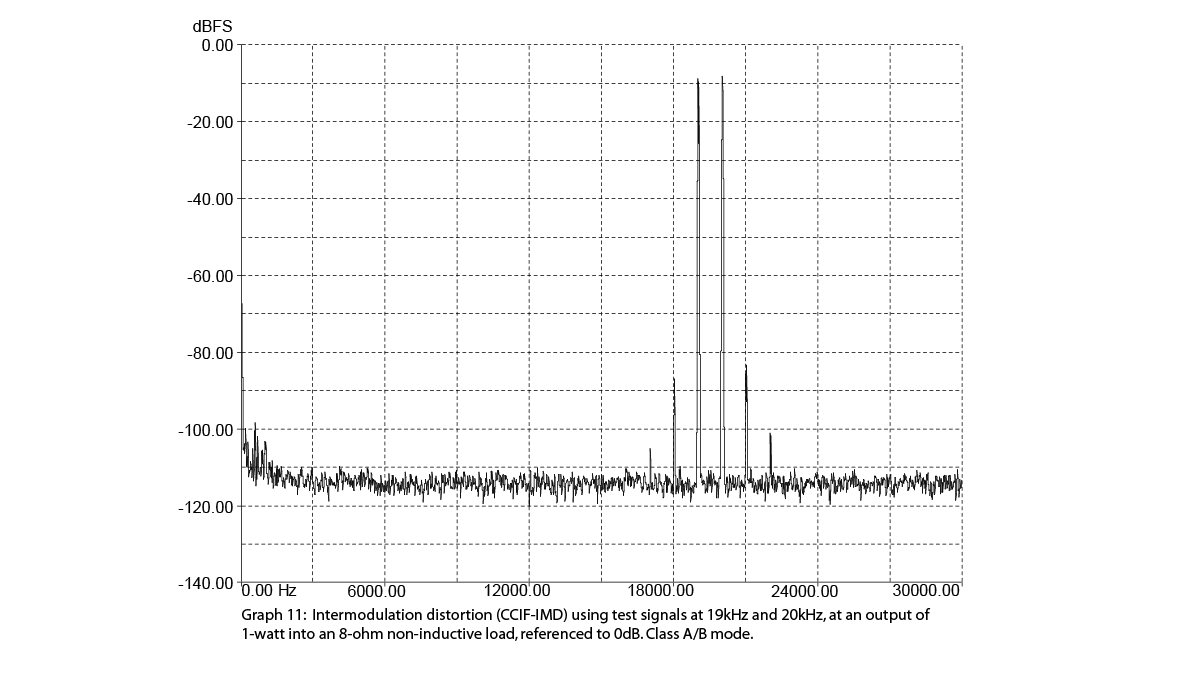
Contrast the IMD result obtained in Class-A mode with that for Class-AB mode in Graph 11. You can see the two sidebands have increased in level and been joined by two further sidebands, plus there’s now an obvious difference signal at 1kHz, albeit still very low in level at –98dB (0.00125%).
Newport Test Labs measured the A-weighted signal-to-noise ratios of the Gryphon Essence pair as 77dB referred to one-watt output and 93dB referred to the 50-watt rated output. Despite being quite respectable results, these should be regarded as ‘worst-case’ figures since these measurements were made with the pre-amp sitting directly on top of the power amplifier in order to give a worst-case result. You will be able to improve on these figures by siting the amplifiers side-by-side, and also positioning them at a little distance from each other.
Output impedance was measured as 0.059Ω (at 1kHz) which gives a damping factor of 135, far more than will be required for the Gryphon Essence Stereo power amplifier to have complete control over any loudspeaker system.
As I would have expected from a Class-A amplifier, the Gryphon Essence is going to consume a lot of power, no matter whether you’re playing soft or loud music. In fact, as you can see from the tabulated figures, this 50-watt per channel amplifier is going to pull more than 300-watts from your 240V mains power supply any time it’s not actually either switched off or in stand-by mode! And you could quite happily leave it in stand-by mode when you’re not using it, because it will draw only 0.67-watts in this mode.
In fact, I would strongly recommend you do leave the Gryphon in standby whenever you are not using it because even if you are not worried about the electricity it will otherwise consume – not to mention the heating effect on your room! – you will extend the operational life of essential semiconductor components inside the amplifier, as well as the operational life of the capacitors in the power supply and elsewhere in the circuitry.
This pair of Gryphon amplifiers delivers very high performance thanks to excellent and innovative design and engineering.
Australian Hi-Fi is one of What Hi-Fi?’s sister titles from Down Under and Australia’s longest-running and most successful hi-fi magazines, having been in continuous publication since 1969. Now edited by What Hi-Fi?'s Becky Roberts, every issue is packed with authoritative reviews of hi-fi equipment ranging from portables to state-of-the-art audiophile systems (and everything in between), information on new product launches, and ‘how-to’ articles to help you get the best quality sound for your home.
Click here for more information about Australian Hi-Fi, including links to buy individual digital editions and details on how best to subscribe.
